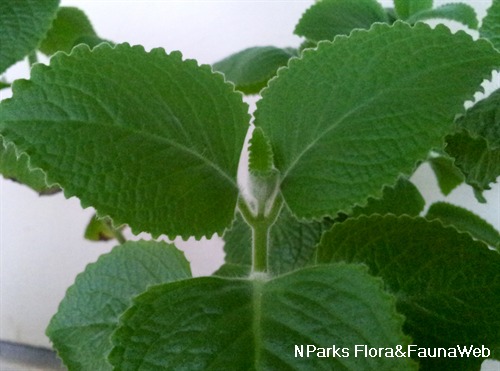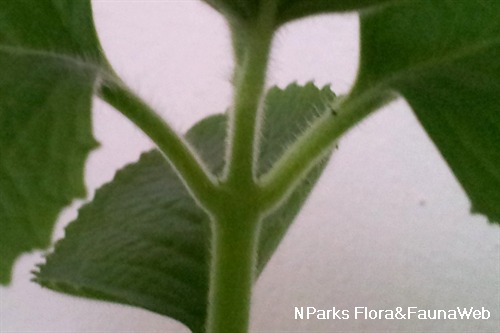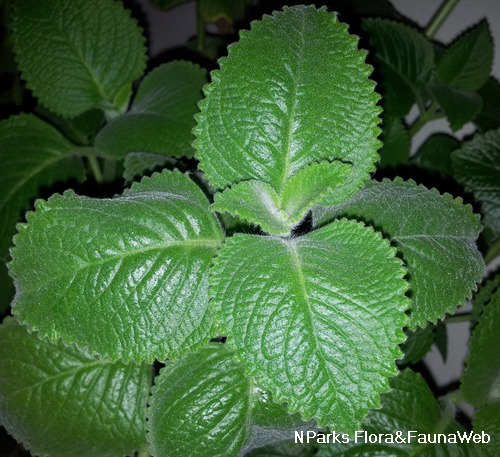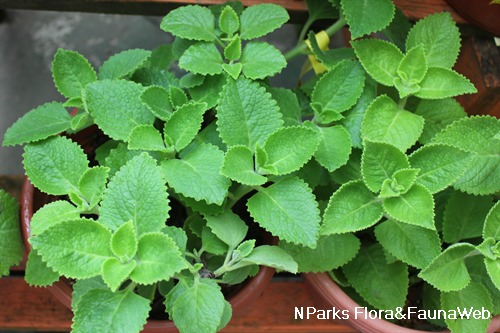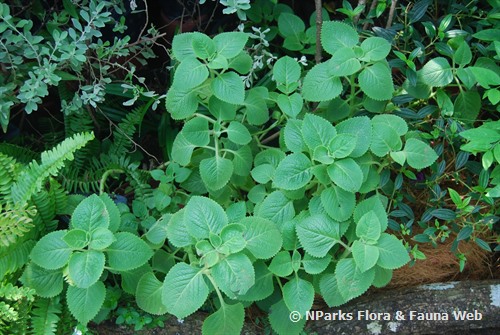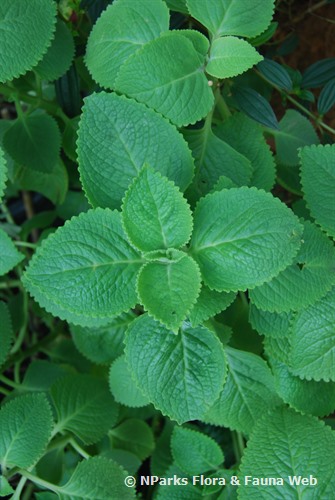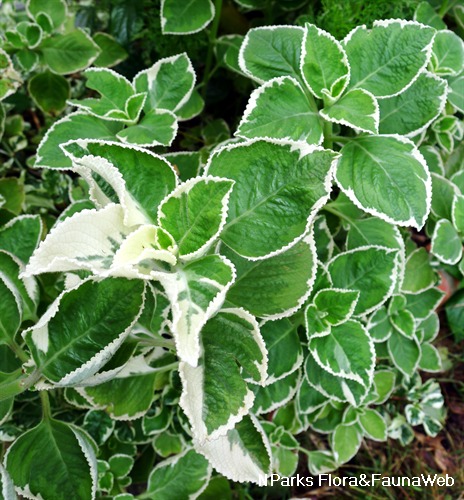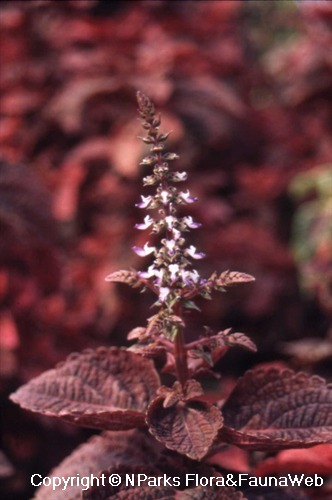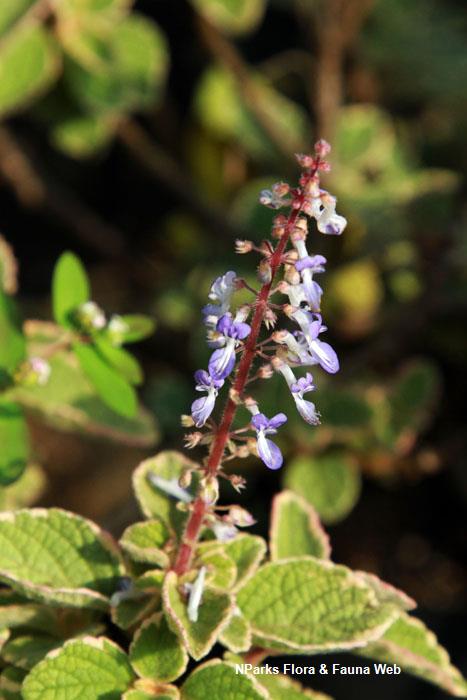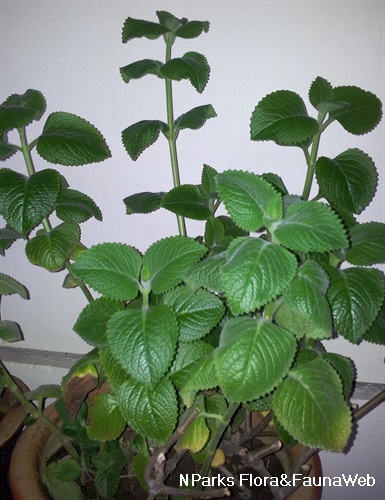
Back
Coleus amboinicus Lour.
| Family Name: | Lamiaceae (Labiatae) |
| Synonyms: | Plectranthus amboinicus (Lour.) Spreng, Coleus aromaticus Benth. |
| Common Name: | Indian Borage, Cuban Oregano, Mexican Mint, Spanish Thyme, 左手香, 到手香, 印度薄荷 |
Name
Classifications and Characteristics
| Plant Division | Angiosperms (Flowering Seed Plants) (Dicotyledon) |
|---|---|
| Plant Growth Form | Herbaceous Plant, Succulent Plant |
| Lifespan (in Singapore) | Perennial |
| Mode of Nutrition | Autotrophic |
| Plant Shape | Columnar |
| Maximum Height | 0.3 m to 1 m |
Biogeography
| Native Distribution | Kenya to South Africa, Arabian Peninsula, India |
|---|---|
| Native Habitat | Terrestrial (Grassland / Savannah/ Scrubland, Disturbed Area / Open Ground) |
| Preferred Climate Zone | Tropical |
| Local Conservation Status | Non-native (Horticultural / Cultivated Only) |
Description and Ethnobotany
| Growth Form | Perennial herb with a climbing or creeping growth habit. It typically grows up to 0.7 m tall, but can be more than 1 m in the wild. |
|---|---|
| Foliage | Leaves simple, thick and fleshy, light green with opposite leaf arrangement (2.5 – 3 cm long, 2.5 – 3 cm wide). Leaves are broadly ovate or triangular in shape (truncate leaf base and a broadly acute apex). Leaf margin is crenate. Lower surface contains numerous glandular hairs, giving a frosty appearance. |
| Stems | Round to approximately 4-sided stems are covered with hairs that are either long and stiff or short and soft. Young, green stem turns brown as it matures. |
| Flowers | 10 – 20 flowers are arranged in a verticil inflorescence (10 – 20 cm long). The flowers encircle the floral stalk at several points along the floral stalk, with points closer together at the tip than at the base. Flower has bell shaped calyx. |
| Fruit | Fruits are smooth nutlets, pale brown n colour. In Singapore, this plant rarely flowers and fruits. |
| Habitat | In Fiji, naturalized plants occur at low altitudes (0 – 250 m) in forests or brush where soil is rocky or sandy. In Tonga, naturalized plants occur in abandoned lands or near roads. It is considered an invasive plant in the Virgin Islands. |
| Cultivation | Plant individuals 40 - 45 cm apart. Requires sandy soil that drains well. It has a fast growth rate. Stems are susceptible to breakage. |
| Etymology | The specific epithet 'amboinicus' is derived from Ambon, an island in the East Indies where Rumphius, a well-known botanist, is from. |
| Ethnobotanical Uses | Food (Herb or Spice): The leaves are used to add flavor to meat and bean dishes, especially in Caribbean cuisine. The flavor is described as being a combination of thyme and oregano. Medicinal: Scientific Evidence of Medicinal Properties In pre-clinical trials, Indian Borage showed anti-inflammation properties in animals that may have potential to treat rheumatoid arthritis. <2> Traditional Medicinal Uses In Taiwan, the plant is used in traditional medicine to treat inflammation or swelling. In Indonesia, Philippines and India, the plant is used as a treatment for coughing. Indonesian women that have given birth sometimes drink soups made with the leaves to promote lactation. Other traditional uses include treating cold, fever, cough, asthma, headache, constipation and skin disease. <1> It is important to note that some therapeutic effects from traditional medicinal uses of plants are not currently supported or verified by scientific research. Others: Volatile oils extracted from the plant have antifungal properties that could potentially protect stored foods from fungal contamination <3>. The essential oils are toxic to some insects. |
Landscaping Features
| Landscaping | Sometimes used as a ground cover. Can be grown in pots or hanging containers. Prized for its ornamental foliage. |
|---|---|
| Desirable Plant Features | Fragrant (Foliage) |
| Landscape Uses | Container Planting, Interiorscape/ Indoor Plant |
| Thematic Landscaping | Economic Garden |
| Plant & Rootzone Preference or Tolerance Remarks | Sandy soil is ideal. |
Plant Care and Propagation
| Light Preference | Semi-Shade |
|---|---|
| Water Preference | Moderate Water |
| Plant Growth Rate | Fast |
| Rootzone Tolerance | Well-Drained Soils |
| Propagation Method | Seed, Stem Cutting, Leaf Cutting |
| Planting Distance | 0 to 0 |
Foliar
| Foliage Retention | Evergreen |
|---|---|
| Mature Foliage Colour(s) | Green |
| Mature Foliage Texture(s) | Hairy / Hirsute, Thick |
| Prominent Young Flush Colour(s) | Green, Green - Light Green |
| Young Flush Texture(s) | Hairy / Hirsute |
| Foliar Type | Simple / Unifoliate |
| Foliar Arrangement Along Stem | Opposite |
| Foliar Attachment to Stem | Petiolate |
| Foliar Shape(s) | Non-Palm Foliage (Ovate) |
| Foliar Venation | Pinnate / Net |
| Foliar Margin | Crenate |
| Foliar Apex - Tip | Acute |
| Foliar Base | Truncate / Square |
| Typical Foliar Area | Microphyll ( 2.25cm2 - 20.25 cm2 ) |
| Typical Foliar Size | 3.5 cm to 5 cm |
Non - Foliar and Storage
| Stem Type & Modification | Herbaceous |
|---|---|
| Root Type | Underground (Tap Root) |
Floral (Angiosperm)
| Flower Colour(s) | Blue, Pink, Purple |
|---|---|
| Flower Grouping | Cluster / Inflorescence |
| Flower Symmetry | Bilateral |
| Individual Flower Shape | Labiate / Lipped, Campaulate / Bell-shaped |
| Inflorescence Type | Verticel |
| Flowering Period | Rarely |
Fruit, Seed and Spore
| Mature Fruit Colour(s) | Brown |
|---|---|
| Fruit Classification | Simple Fruit |
| Fruit Type | Indehiscent Dry Fruit , Nut / Nutlet |
References
| References | <1> Arumugam, G., Swamy, M.K. & Sinniah, U.R. (2016). Plectranthus amboinicus (Lour.) Spreng: Botanical, Phytochemical, Pharmacological and Nutritional Significance. Molecules. 21(4):369-395. <2> Chang, J.M., Cheng, C.M., Hung, L.M., Chung, Y.S. & Wu, R.Y. (2010). Potential Use of Plectranthus amboinicus in the Treatment of Rheumatoid Arthritis. Evid Based Complement Alternat Med. 7(1):115-20. <3> Murthy, P.S., Ramalakshmi, K. & Srinivas, P. (2009). Fungitoxic activity of Indian borage (Plectranthus amboinicus) volatiles. Food Chemistry 114(3): 1014-1018. |
|---|
Image Repository
Others
| Master ID | 29408 |
|---|---|
| Species ID | 3717 |
| Flora Disclaimer | The information in this website has been compiled from reliable sources, such as reference works on medicinal plants. It is not a substitute for medical advice or treatment and NParks does not purport to provide any medical advice. Readers should always consult his/her physician before using or consuming a plant for medicinal purposes. |

